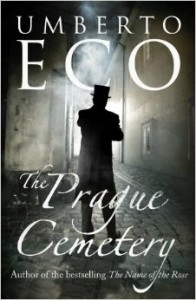#17 The Prague Cemetery, by Umberto Eco
 I’m one of those odd creatures who believes Umberto Eco’s masterwork to be Foucault’s Pendulum, not The Name of the Rose. The Prague Cemetery did not challenge this view for me.
I’m one of those odd creatures who believes Umberto Eco’s masterwork to be Foucault’s Pendulum, not The Name of the Rose. The Prague Cemetery did not challenge this view for me.
It’s a fantastically constructed novel (as in fantastical, rather than fantastic) which drapes a veil of fiction around some of the most unpalatable facts of modern European history. It opens with a diatribe that is rather like the work of some modern stand-up comics; by at once shocking and delighting it keeps you in your seat after you really wish you’d left … and that’s how the book continued.
The Prague Cemetery is a bravura piece, which is to say that in part its virtuosity is essential to create an appetite to continue reading – after the opening section which virulently attacks Jews, the protagonist Simonini goes on to launch venom at every other nation in Europe which is a bit like not minding getting vomit on your shoes because everybody else got splattered with it too.
There are the usual Eco elements – a rich tapestry of gargoyle characters who spend all their time trying to knock lumps out of each other, diplomatically, physically and financially; sprawling geographies (France to a not-yet united Italy, Prague and Russia, Prussians and Germans and even a strange split-personality American woman who is pivotal to the linking of two great conspiracy theories – the Catholic Church and the Masons; there’s a vast sweep of history and many digressions into fascinating areas of specialisation (the discussions of the bomb makers around the relative merits of the explosives at their command combine the confident narration of a TV cookery programme with the endless nerdy hilarity of a Monty Python shrubbery sketch) and of course an unreliable narrator … or two … or three.
There’s Simonini himself, then Abbé Dalla Piccolla who keeps writing in Simonini’s diary whenever Simonini falls asleep and then The Narrator, an interjector who attempts to clarify and sometimes simplify the ramblings of both the other narrators, each of whom believes the other to be breaking in and adding commentary to the narrative for nefarious purposes.
Slowly and unavoidably, the spiral of the narrative tightens inwards, Simonini is a man without friends, lovers or scruples. He enjoys a good meal and prefers to eat alone, hoards money and murders almost in passing, when people become inconvenient. Beginning by blowing up the ship on which Italian patriotic hero Nievo is travelling – and just incidentally killing said hero and the entire crew – Simonini’s obsession is with documents and documentation. He’s an expert forger and a creator of skewed narrative, a man who creates horror stories to order and then, eventually, for his own satisfaction. His opening tirade is no accident – the only motivation he has, other than money, is to discredit and destroy the Jewish race. That he does so by creating the Protocols of Zion, a historical fantasy used by Hitler, amongst others, as a justification for pogroms and the Final Solution, may seem like a mind-boggling misappropriation of fact. It’s not. The only true invention n the entire book is Simonini himself – the events, the forgeries, the skullduggery, the endless narrations of devil worship, child cannibalism, perversion of innocence and perversion of truth are all historical facts, all levelled by the other people in the book, who are not inventions but historical personages, the only complete fiction is Simonini himself. Even the Lucifer invoking, demon-worshipping Diana Vaughan, despite being an invention, was not invented by Eco but by Leo Taxil, a noted hoaxer.
As an aside, I’m not sure whom the cover is meant to depict. Simonini himself is clearly no slim, debonair man-about-town – he describes his own substantial figure resulting from good food, which means at least ‘portly’ and possibly even just fat. It’s yet another one of those images that seems to have been designed for a television audience, rather than as any kind of summary or impression of the novel.
Simonini’s own narrative peters out after his great ‘masterwork’ the Protocols of Zion, are created and Eco dangles this protagonist’s disappearance in front of us in a fairly perfunctory fashion – having served his purpose in bringing a hideous evil into the world, Simonini is no longer required.
What remains, after he leaves the stage, is the vitality of his final, nauseating forgery – a document entirely imagined and thereafter used as if it were a verifiable treatise on the planned Jewish overthrow of every society using a hydra-headed set of ‘weapons’ from infiltrating education to alcohol, from lust to mass transportation. This ridiculously overblown account of the secret meeting in a Prague Cemetery of rabbis from around the world has outlived its creators, its adherents and those who used it to justify genocide – and it still sells today in some parts of the world, not as fiction but as a document pertaining to be a real account of a Jewish masterplan. Eco’s real skill is always to leave us face to face with the complexities of reality – and in this book I fear he may have done so to such good account that he runs the risk of reinvigorating a lie that can travel halfway around the globe while the truth is still putting on its shoes. When that lie has caused such atrocities, anything that gives it fresh energy, no matter how bravura the construction, strikes me as likely to create more grief.


Recent Comments